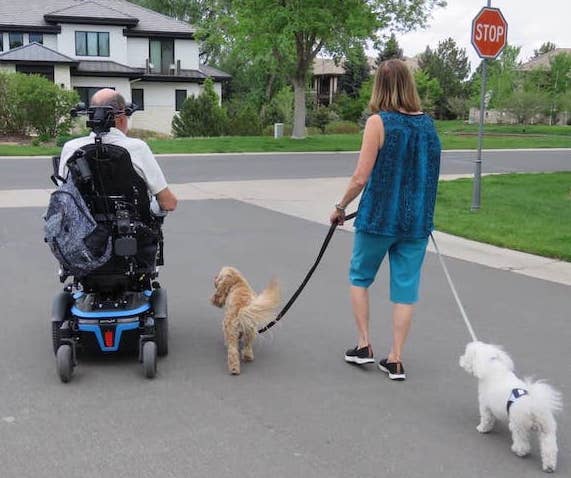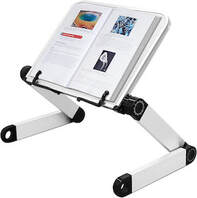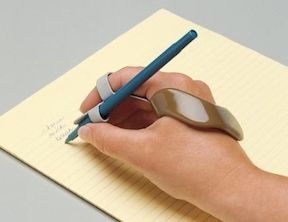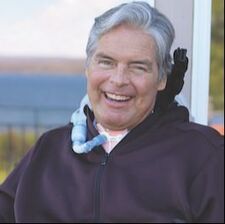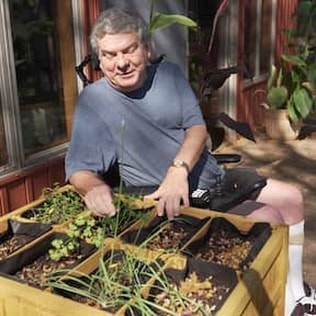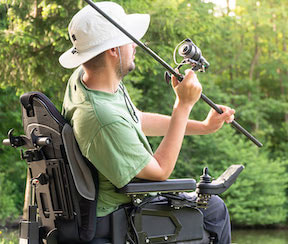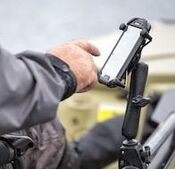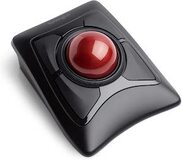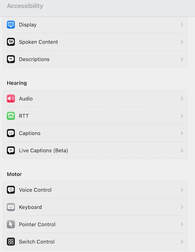|
Making modifications and using adaptive devices may help you continue to do some of your favorite activities. Doing something you love—whether an art, hobby, game, sport, or activity—can bring deep joy and fulfillment. As ALS progresses, the thought of not being able to do something you love can be extremely difficult. Depending on the activity, however, there may be assistive devices or modifications that let you continue to enjoy all or part of that activity or experience. If you notice it is becoming more difficult to do something you love, ask the occupational or physical therapist on your ALS clinic team or medical team if there are any adaptive strategies or devices that could help you continue to do that activity. You may be surprised to learn what is possible, either through a physical modification or digital alternative. No matter the stage of the disease, it is important to continue living and doing things you love, even if in a modified way. |
|
Exploring Adjustments and Modifications
|
There are many different types of adaptive devices that can help you continue to do activities in a modified way. You may also be able to modify the activity itself or find ways to enjoy core aspects of what you love about the activity.
Every individual, activity, and situation is unique, so you may need to be creative, think outside the box, and go through a process of trial and error to figure out what works best for you at each stage of the disease. |
|
There are too many pastimes to specifically address each one here, but below are examples of some common activities and potential modifications. Even if your interests are not listed, these examples may prompt you to think about how you might go about modifying your favorite activity.
|
PAINTING If you love to paint, but are finding it harder to hold your brush, you can try building up the handle with foam tubing, tape, or anything else that makes it easier to grip. If that doesn’t work, you can try putting your brush in a universal cuff. If using a physical paintbrush is no longer possible, there are many apps and programs that can help you make art digitally.
|
|
PHOTOGRAPHY If you are finding it difficult to hold or operate your phone or camera, there are different mounting and control options that can allow you to continue to enjoy photography. If you have a wheelchair, you can mount your camera onto your chair, move about, and snap photos with your touchscreen, voice, eyes, or switches that can be activated by your head, hand, or foot. You can then use a program or app to edit your photos digitally.
|
|
READING If you are starting to have trouble holding a physical book, you can try devices like a book stand or clipboard or clip that can hold your book open. Alternatives to physical books include listening to audiobooks and reading electronic versions with an e-reader or tablet. You can also read or listen to digital versions of newspapers, magazines, and other media.
|
|
WRITING If you write—whether for work, communication, or self-expression—there are ways to continue writing. For handwriting, you can try a slip-on grip, universal cuff, functional wrist brace, or ergonomic arm support. For typing, you can press keys with a slip-on typing aid or stylus that you can either hold in your hand or tuck into a universal cuff. If you are unable to use your hands, you can write using speech-to-text dictation, a head mouse, or eye-tracking technology.
|
|
Author and former NFL player Tim Green wrote his latest novel using eye-tracking technology. “Writing is a major part of my life,” he writes. “The process takes me away to another time and place, and when I'm writing it's the same state as before I was diagnosed. I'm grateful for the technology that allows me to continue to do it. Bring a patient attitude. If you persevere, the world remains open to you.”
|
|
GARDENING If you like to grow flowers, herbs, or vegetables, there are different ways you can continue to enjoy gardening. Garden kneelers with handles, special adapted gardening tools, raised beds, and drip systems on timers can make gardening easier and more accessible. If you are unable to actively garden but love fresh flowers, tasty herbs and vegetables, and just being outdoors, you can always ask family, friends, and neighbors to help set up and maintain your garden.
|
|
PLAYING GAMES If you like to get together with others to play cards, for example, you can try using a card holder, asking for assistance when needed, or playing with a partner. There are also many digital versions of card games and other games that you can either play on your own or remotely with friends. You may even discover new online games that you can play with a wider gaming community.
|
|
GOLFING If you are finding it harder to play golf, there are adapted clubs as well as special gloves that can help improve your grip. If swinging your clubs becomes too challenging or exhausting, you could still ride in the cart and chip or putt as you approach the green. If you can no longer play but still enjoy getting out on the course with others, you may be able to modify the seat on the golf cart to ride along and socialize.
|
|
FISHING If you are finding it harder to cast and reel, there are automatic casters and reels that can help. If you are in a wheelchair, you can attach a rod holder to your chair. If you are unable to reach a boat or fishing spot, you may be able to build or set up a ramp to help you get there. You can also look for locations with easier access, such as a dock or a pier. If you are unable to fish but still enjoy being outdoors near water, you can still try to join others on outings.
|
|
PLAYING SPORTS Some sports may be modified so that you can continue to actively participate, even from a wheelchair. More physically demanding sports may be harder to modify. To learn what is possible, ask your physical or occupational therapist and local ALS organization for suggestions. Ask if there are any adaptive sports programs in your area. For ideas, you can also search online using terms like “adaptive tennis” or “adaptive skiing.”
|
|
GETTING OUTDOORS If you like to spend time in nature, you can still find ways to get outdoors as long as you have the right mobility devices and access to transportation. Walking or riding along accessible trails or scenic sidewalks, or even just sitting in your backyard, can provide a nice change of scenery.
If you love going to the beach, there are special manual beach wheelchairs with wide wheels that can roll across the sand without sinking. You may be able to find them at beach entry stations or lifeguard stations and headquarters. |
|
|
TRAVELING Taking trips when living with ALS will be more challenging, but with planning, patience, support, and the right equipment, you can find ways to visit loved ones, return to your favorite places, and explore new destinations.
You can rent accessible vans for road trips and fly on commercial airlines as long as you can sit in a standard airplane seat for the duration of the flight. Learn more on our Traveling with ALS page. |
|
If you find that you can no longer do a favorite activity, even with modifications, you can take the opportunity to try something new that you’ve been curious about but haven’t had the time to pursue. You might discover and develop new interests and pastimes.
|
After his diagnosis, Ed and his wife Dolly traveled to Europe, Mexico, Costa Rica, and South America. Two months before he passed, they ventured to southern Argentina to see Patagoinia’s massive glaciers and iconic peaks. “Traveling with ALS can be one of the greatest challenges you will face,” says Dolly, “but the reward is so great.” Read more
|
Accessing Your Digital Devices
|
Recent advances in technology have made it possible to do many things—such as making art, playing games, attending virtual events, and controlling smart home devices—as long as you can access your phone, tablet, or computer.
If you find that it is getting harder to access your phone, tablet, or computer, reach out to your occupational therapist and speech language pathologist to request an evaluation and ask for suggestions. There are many assistive devices that can address a wide range of needs. |
|
If you are finding it hard to hold your phone or tablet, there are devices like tabletop phone stands, table clamp holders with arms, and wheelchair mounts that can hold your device for you.
If you like to use a stylus on your touchscreen but are finding it challenging, a simple finger sock or extended stylus may help. If you can type more easily on a full-size keyboard than on your phone or tablet, you can connect a wired or wireless keyboard to your device. And if you are starting to have trouble using a standard mouse, there are many mouse variations, including trackballs and joysticks.
If you like to use a stylus on your touchscreen but are finding it challenging, a simple finger sock or extended stylus may help. If you can type more easily on a full-size keyboard than on your phone or tablet, you can connect a wired or wireless keyboard to your device. And if you are starting to have trouble using a standard mouse, there are many mouse variations, including trackballs and joysticks.
If you can speak but are unable to use your hands, there are speech-to-text apps and programs that can allow you to click, write, surf the web, and control your device. Check and try the built-in accessibility features on your device before paying for an app or program like Dragon Pro. If you want to purchase an app or program, make sure it is compatible with your operating system first. Getting an external microphone may improve your program’s ability to understand your speech.
Another option is using hands-free voice assistants, like Siri for Apple products and Google Assistant for Android devices. Getting a voice-activated smart speaker will allow you to do even more with these digital assistants.
Another option is using hands-free voice assistants, like Siri for Apple products and Google Assistant for Android devices. Getting a voice-activated smart speaker will allow you to do even more with these digital assistants.
Built-In Accessibility FeaturesYou may be surprised to find that your current device already has a variety of free, helpful accessibility features like speech-to-text dictation, mouse/trackpad adjustments, keyboard customization, shortcuts, and more. Search for the accessibility settings control panel on your device and explore the different features to determine what might be most helpful.
|
If you are unable to speak or use your hands, there are additional access methods such as the head mouse, which allows you to direct your mouse across the screen by moving your head. You can also use eye-tracking technology, either with a speech-generating device or by connecting a special camera to your tablet or computer.
Learning new ways to access your devices can be a slow and frustrating process, but with practice it should get faster and easier. Continuing to practice will allow you to stay connected with others and do more on your own.
Learning new ways to access your devices can be a slow and frustrating process, but with practice it should get faster and easier. Continuing to practice will allow you to stay connected with others and do more on your own.
Do you need assistance with digital access and devices?
|
Most digital access devices, except for speech-generating devices, are not covered by insurance. If you need assistance accessing your phone, tablet, or computer, there are a number of resources that should be able to help.
Begin by sharing your challenges and needs with an occupational therapist or assistive technology professional (ATP). They should be able to do an evaluation and make suggestions. If you have a speech-generating device, a technology professional from the manufacturer should be able to help with training and troubleshooting. |
|
The nonprofit organization Bridging Voice offers a range of personalized services that can help you with computer access and communication technology needs. At no cost, a speech language pathologist can conduct a remote evaluation to determine the technology that would best address your needs. Bridging Voice can educate you on low-cost options, guide you in obtaining the technology, help you set it up, and then provide ongoing support, training, and customization.
The ALS nonprofit organization Team Gleason may be able to recommend or provide some loaner communication devices. Learn more about what Team Gleason offers on their PALS Resource and Communication Devices pages.
Another option is asking your local ALS organization if they might be able to lend you some devices from their equipment loan closet.
The ALS nonprofit organization Team Gleason may be able to recommend or provide some loaner communication devices. Learn more about what Team Gleason offers on their PALS Resource and Communication Devices pages.
Another option is asking your local ALS organization if they might be able to lend you some devices from their equipment loan closet.

